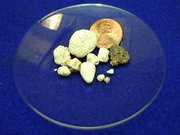Phosphate
|
|
In chemistry, a phosphate is a polyatomic ion or radical consisting of one phosphorus atom and four oxygen. In the ionic form, it carries a -3 formal charge, and is denoted PO43-.
In a biochemical setting, a free phosphate ion in solution is called inorganic phosphate, to distinguish it from phosphates bound in the form of ATP, or perhaps in DNA or RNA. Inorganic phosphate is generally denoted Pi. Inorganic phosphate can be formed by the reactions of ATP, or ADP, with the formation of the corresponding ADP or AMP, and the release of phosphate ion. Similar reactions exist for the other nucleoside triphosphates and diphosphates.
In living systems, phosphate ions can also be created by the hydrolysis of a larger ion called pyrophosphate, which has the structure P2O74 -, and is denoted PPi.
- P2O74 - + H2O → 2HPO42-
Energy stored by phosphate bonds in the form of ADP or ATP, or other nucleoside diphosphates or triphosphates, or the phosphagens in muscle tissues, is generally referred to as high energy phosphate.

In mineralogy and geology, it refers to a rock or ore containing phosphate ions.
In ecological terms, phosphate is often a limiting reagent in many environments--the availability of phosphate governs the rate of growth of many organisms. Introduction of non-naturally occurring levels of phosphate to those environments causes an ecological disequilibrium, leading to booms in the population of some organisms and subsequent busts in the populations of others deprived of other nutrients or essential elements by the rapid growth and consumption by the booming population.
Phosphates are often used in laundry detergent as a water softener, but because of boom-bust cycles tied to emission of phosphates into watersheds, phosphate detergent sale or usage is restricted in some areas.
In agriculture phosphate refers to one of the three primary plant nutrients, and it is a component of fertilizers. Rock phosphate is quarried from phosphate beds in sedimentary rocks. In former times it was simply crushed and used as is, but the crude form is now used only in organic farming. Normally it is chemically treated to make superphosphate, which has a higher concentration of phosphate and is also more soluble, therefore more quickly usable by plants.
Fertilizer grades normally have three numbers; the first is the available nitrogen, the second is the available phosphate, and the third is the available potash. Thus a 10-10-10 fertilizer would contain ten percent of each, with the remainder being filler.
The largest rock phosphate deposits in North America are in North Carolina and Florida. The largest in the world are in Nauru, which used to have phosphate of best quality.
Leaching of phosphates from fertilized farmland can be a cause of phosphate pollution of surface water, causing algal bloom and consequent oxygen deficit for fish in the same manner as phosphate-based detergents.
See also
da:Fosfat de:Phosphate fr:Phosphate nl:Fosfaat no:Fosfat pl:Fosforan pt:Fosfato sv:Fosfat
